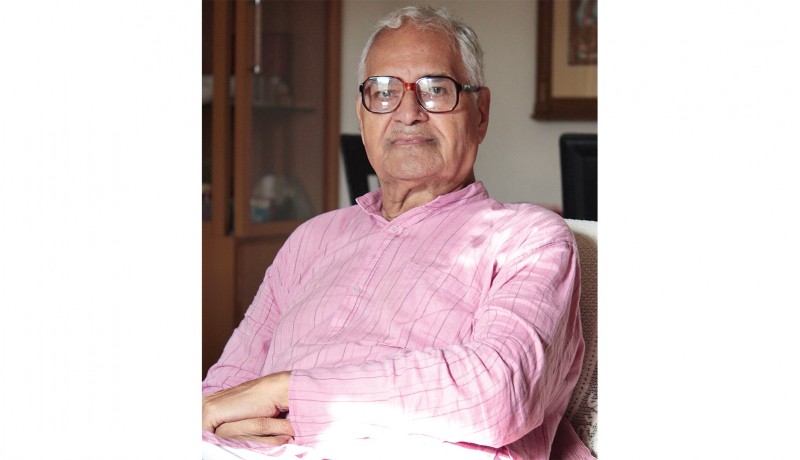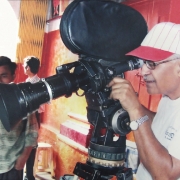
People

Documentaries do justice to our vibrant culture, veteran filmmaker G L Bhardwaj tells Aditya Seth
He is virtually a one-man army—ideating, scripting, producing, directing and editing short films, besides, of course, handling the camera. Nonagenarian filmmaker Gurcharan Lal Bhardwaj, who worked as a still photographer with Raj Kapoor and later went on to make award-winning documentaries including Shocking Asia and Land of Krishna, is the oldest practising short filmmaker in India currently.
A self-taught filmmaker, Bhardwaj has won several national and international awards, including the prestigious President’s Award and lifetime achievement award from the Indian Cine Film Festival for his contribution to documentary and short cinema. Besides the Films Division of India, he has worked for several foreign film production houses including New York-based American Broadcasting Company and London-based Worldwide Television. The 91 year-old Mumbai-based filmmaker, who helms Bhardwaj Films, reveals how the words ‘Lights, Camera, Action’ still charge him up.
IN HIS OWN WORDS
As a child, I was good at sketching portraits. There were no images of my father at home, as he had passed away when I was only five. I drew a picture of him from memory. My mother approved of it, affirming that my father, indeed, looked like that.
It was very hard for my mother to bring us—my elder brother and I—up alone. My childhood was pretty unpleasant, though it pushed me to come up in life. I was in 12th grade when Partition was announced and we moved from Lahore to Simla. I had moved before Partition and established myself before I brought my mother. My brother came 15 days after Partition.
Struggler days
I visited Bombay a couple of times in search of a job. I had read that if you want to become a filmmaker, you will need a producer, a cameraman and many technicians, but if you are a cameraman yourself, you are a full-fledged filmmaker. Somehow, that line stayed with me, and I decided to become a cinematographer.
In Bombay, I was a struggler, with no work and no place to stay. Director Prahlad Datt, who was working on a film called Nazare, hired me as an unpaid apprentice and assistant for a year at Ranjeet Studio. I was part of the camera department and my job was to check the footage to see if the shot was perfect. On the set, I observed and learnt a lot. I used to get about ₹ 75 from home every month. In Dadar, there was a small restaurant that would sell two square meals for about ₹ 38 per month. I used to live in Versova, which wasn’t too expensive but travelling every day from Versova to Dadar wasn’t convenient. So I used to sleep in the makeup room above the studio.
Learning the ropes
From taking meter readings to studying lighting, colour correction, etc, I went through the entire process. Though I never got to work with veteran cinematographer Raju Karmakar, he would appreciate my work whenever I would send him my stills. I even used to edit on my own. I would make my own sequences, go to the studio and record over there. I have made over a hundred films.
I am a self-taught professional. I took inspiration from those I worked with. They gave me work, appreciated my inputs, and corrected me when needed. I took their advice and guidance to help improve my work. I consider veteran director B S Thapa my guru. He gave me work and appreciated my contribution. I even made a short film on his journey from being the head officer of the cavalry in the military to chief producer at Films Division, called Romance Behind The Camera.
The Kapoor connection
After a while, I left Bombay for Mussoorie and opened a studio there. One day Raj Kapoor’s assistant Prakash Arora came over and told me Kapoor wanted me to shoot some stills for his next film. Arora had a two-bedroom flat in Bandra. I took one of the rooms on rent and brought my mother along.
How I eventually landed the job is interesting. After looking at his stills that I had shot, Kapoor turned around and asked me if that was how all the stills had turned out? I told him I had shot, edited and printed them all myself. He was impressed and gave me the job. I was earning around ₹ 10,000 at that time, which was a lot in those days, so I decided to buy a high-end camera.
I shot stills for films such as Aah, Boot Polish, Shree Chaar Sau Bees and Ab Dilli Door Nahi. After Ab Dilli Door Nahi, Kapoor’s cinematographer Achrekar asked me if I worked outside Bombay. While not denying it, I asked him in return about his work outside Bombay. He said his was a different case. I told him that if he wants to send me a red letter, I will serve him one instead—and I was out.
Delving into documentaries
After a few days, my aunt told me about an opportunity to make a film on a sugar mill for ₹ 10,000. I got ₹ 2,000 as advance and bought myself a camera for ₹ 1,700. I even lent my voice to the film. Documentary filmmaking was the ‘in thing’ those days because of Films Division. I made about 100 films, both long and short, of which about 50 ran in cinemas. Once industrialist-politician G D Birla got a special request from late prime minister Indira Gandhi to have a film made on students. Gandhi loved the concept of my film, Fifth Sense, and asked me to give it to Films Division for screening.
In a country such as India, documentary films work well as they help bring out the richness of our culture. Earlier, cinemas used to pay Films Division for showing these films. It’s indeed sad that they don’t show documentaries in cinemas these days. Today, cinema tickets are expensive and what the audience gets in return is unrealistic and unbelievable fare.
Wildlife films
I’ve always enjoyed shooting wildlife films. I have never used stock shots in any of my films. Once I waited for four days to get the shot of a lion! I remember I was sleeping in the wild, when my son woke me up and said there was a lion right next to my camera. I found it roaring at the camera. Though the sound was picked up, the lion moved away and I was unable to get a complete shot. Fortunately, I managed to get the shot when he came back to drink water.
Films are a hit or miss business; sometimes they set the box office on fire, sometimes they flop. On the other hand, documentaries promise a steady income and lifestyle. Moreover, the bravery of a documentary filmmaker to persist in difficult situations is remarkable.
Silver years
I am ageing, have joint pains and can’t run around sets with my camera. Earlier, I have wielded the camera for Hearst Metro news, EBC news and ITN, running around, shooting all day long. When it comes to health, I feel self-appreciation and simple living work best. I have always enjoyed eating home-cooked food.
Work all the way
Retirement is a personal choice. To date, I don’t say I am retired, and look to work as much as I can. As age is catching up, I’m looking for someone who can help me finish my pending films. I have never lost the willingness to work, and will retire only when I feel like I can’t do it anymore. Till then it’s lage raho Munna bhai!
Photo: Mehek Seth Featured in Harmony — Celebrate Age Magazine December 2018
you may also like to read
-
For the love of Sanskrit
During her 60s, if you had told Sushila A that she would be securing a doctorate in Sanskrit in the….
-
Style sensation
Meet Instagram star Moon Lin Cocking a snook at ageism, this nonagenarian Taiwanese woman is slaying street fashion like….
-
Beauty and her beast
Meet Instagram star Linda Rodin Most beauty and style influencers on Instagram hope to launch their beauty line someday…..
-
Cooking up a storm!
Meet Instagram star Shanthi Ramachandran In today’s web-fuelled world, you can now get recipes for your favourite dishes at….








